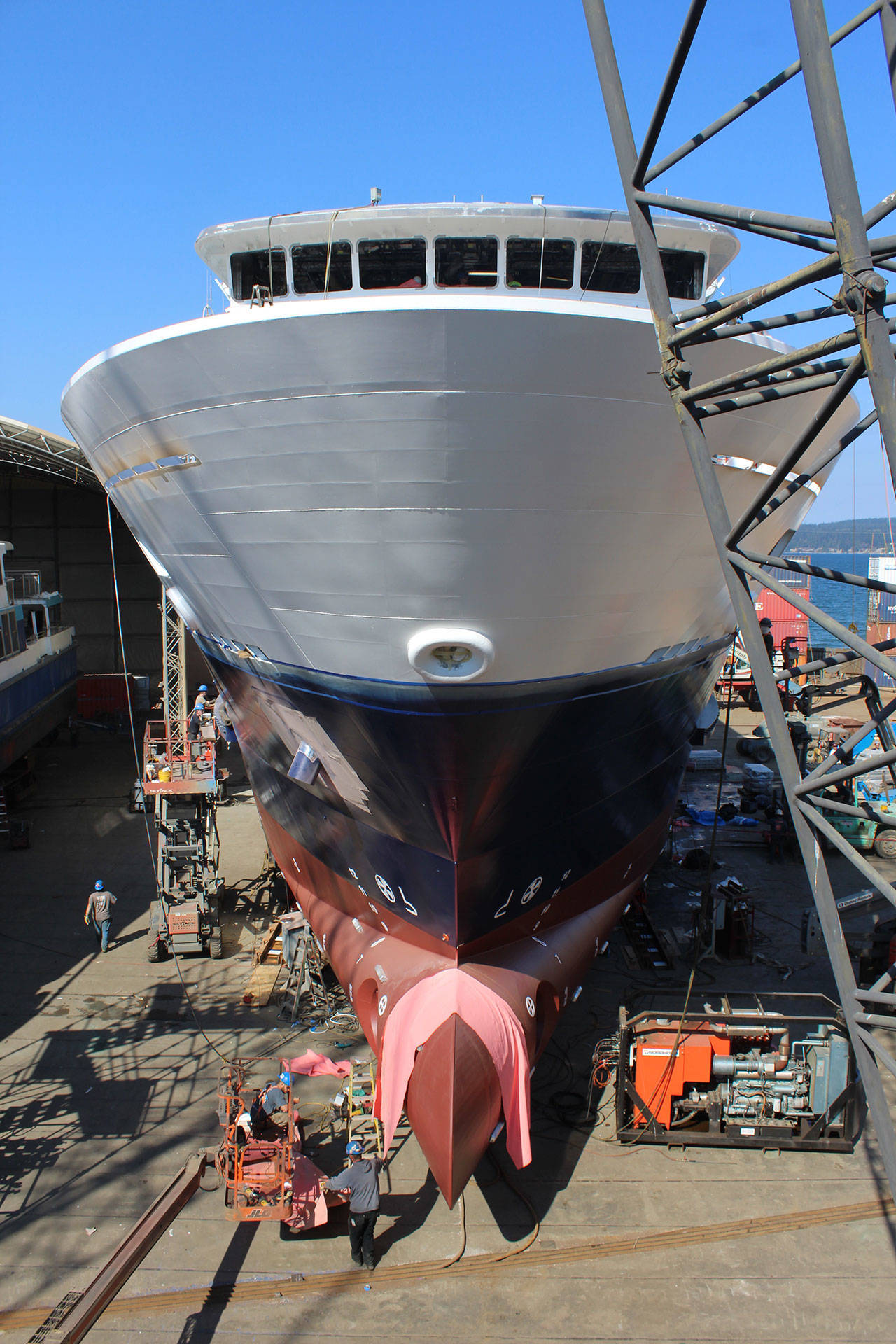A sleek new cruise ship bound for adventures from the warm waters of Baja to the northern reaches of Alaska must first overcome another 800 feet of land before voyaging off to sea.
That could take four days.
Thursday, the freshly painted blue and white “mini” cruise ship moved 85 feet sideways inside Nichols Brothers boat yard to get lined up on two tracks that compose a skid launch system.
The vessel is 240-feet long, 46-feet wide, weighs 1,700 tons and has 50 cabins.
“We only have a 12-hour window of low tide,” said facility supervisor Scott Statia who was helping lay metal plates across Shoreline Drive. “We’re going to follow out to the low tide, which is 6:30 p.m. Saturday, and Monday, it floats off.”
Shoreline Drive between Cameron Road and Woodard Avenue closed Thursday and should reopen Monday if all goes according to the plan.
Named National Geographic Venture, the 100-passenger vessel is the second of two “pocket” cruise ships the Freeland shipyard built for Lindblad Expedition Holdings. Lindblad is a pioneer in eco-friendly tourism — combining luxury with adventure and environmental stewardship with wellness specialists and award-winning cuisine.
The Lindblad-National Geographic partnership includes eight ships.
Last June, Nichols Brothers launched the sister ship of Venture named National Geographic Quest. The contract for both ships is about $95 million.
Venture is being backed into the water, stern first. The bow is not pointy, but softly rounded with a large observation deck that can accommodate all passengers at once for wildlife observations.
Last-minute touches were still being applied Thursday. One worker used a four-inch roller to paint a rather long stripe of yellow; two others applied logos of the two companies. Venture is bound only as far as the Nichols dock in Langley where interior work will be completed.
While the two ships are similar in size and specifications, Venture is built with an aluminum superstructure instead of steel. “That will really lighten the vessel,” Nichols said.
Compared to other commercial cruise lines, Lindblad’s ships are tiny and rather quaint. But they also go where bigger ships can’t — to remote regions of the world like the Galapagos, the Amazon, Antarctica. Smaller and lighter translates into being able to get easily on-shore to see wildlife and explore terrain. Lindblad ships use a fleet of rigid inflatable boats for many land and water activities.
“That’s why they’re called pocket ships,” Nichols said. “They can maneuver in and out places and ports big ships can’t.”
The largest cruise ship in the world, Royal Caribbean’s Symphony of the Seas, has 18 decks, 22 restaurants, 24 pools, 2,759 cabins and a park with 20,000 tropical plants. And the world’s tallest water slide. It accommodates some 6,000 passengers who are served by more than 2,000 on-board staff.
By comparison, the 100 guests aboard Venture will be taken care of by 50 staff members. Meals are served in one dining room, and there’s a lounge, bar, sundeck, fitness center and wellness spa.
This is the 190th vessel Nichols Brothers Boat Builders has built and launched since 1964. The company also constructed the smaller sister ships, National Geographic Sea Bird and National Geographic Sea Lion, that have been operating for decades.
The company doesn’t publicize when it plans to launch the behemoth boats from its unassuming facility. But it doesn’t mind on-lookers as long as they heed safety precautions.
“It seems very unlikely something that big is going to roll out across the street,” Ed Evans, a Freeland neighbor, commented while peering from a distance. “It’s always amazing to see what they do here.”
Evans watched with his friend, Jerome White, visiting from San Francisco.
“One of my goals in life is to see a ship launch,” White said.
So great timing, right?
“No, we’re leaving Saturday,” he said, “for a cruise.”


